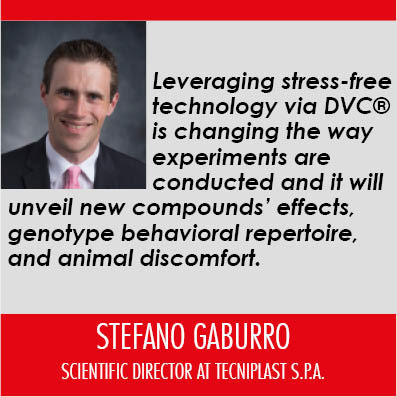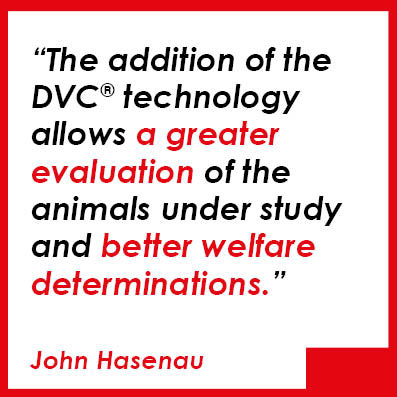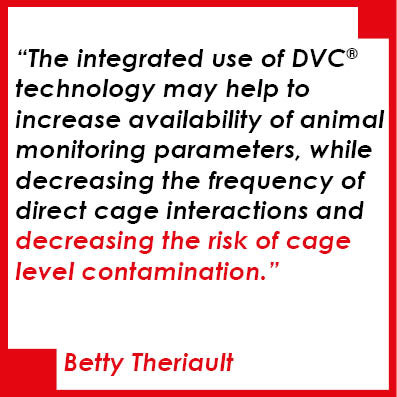
The current version of the Tecniplast website doesn't match your region. Please visit your local website to find information and offerings specific to your country.

The current version of the Tecniplast website doesn't match your region. Please visit your local website to find information and offerings specific to your country.

Betty Theriault, John Hasenau and Stefano Gaburro were main speakers at the last webinar on Gnotobiology, discussing new trends while using DVC® System
The last webinar on Gnotobiology entitled “Present and Future Gnotobiology trends; opportunity for improving animal modelling, with the use of 24/7 bio-exclusion home cage monitoring housing systems” was moderated by Stefano Gaburro, Scientific Director at Tecniplast S.p.A. and conducted by Betty Theriault (DVM, DACLAM) and John Hasenau (DVM, DACLAM). They show us the results they have attained in this interesting online event.
 Stefano, as a moderator of the webinar, can you summarize the outstanding results obtained with the DVC® technology?
Stefano, as a moderator of the webinar, can you summarize the outstanding results obtained with the DVC® technology?
The Digital Ventilated Cage (DVC®) technology-based discoveries were an eye-opener for many researchers both as regards welfare and science. For instance, just to name a few the important work of Pierson and co. University of Oxford regarding how the room light can affect the locomotion in the animals 15 fold, or how the effects of cage change can persist up to 5 days. Therefore, cage-change activities should be taken into account if experiments are to be run in the following days. In conclusion, leveraging stress-free technology via DVC® is changing the way experiments are conducted and it will unveil new compounds’ effects, genotype behavioral repertoire, and animal discomfort.
 John, why do you think that this new technology is so important for the gnotobiology community?
John, why do you think that this new technology is so important for the gnotobiology community?
With the use of the hermetically sealed housing system technology becoming more accepted to allow greater study diversification and increased throughput in the same foot space, there has also been the need for enhanced animal monitoring.
The addition of the DVC® technology allows a greater evaluation of the animals under study and better welfare determinations. This can help with reproducibility and rigor, and associated study data outcomes and very importantly biosecurity of the units.
Betty, Gnotobiology has an ongoing exponential increase usage in studies. Do you think that the DVC® technology can support this trend?
Trends in recent years have been towards the incorporation and use of hermetically sealed caging systems to enhance capacity and throughput in gnotobiotic operations. Inherent in the use of these caging systems is the risk for cage level contamination with each cage intervention. Additionally, cage interventions require the use of biological safety cabinet usage, and the more investigators that may need to share these resources (hermetically sealed caging systems and biosafety cabinet equipment), the more time constraints may exist for access.
 My opinion is that the integrated use of DVC® technology as it relates to monitoring germ-free or ex-germfree animals utilised in interventional studies, may help to increase availability of animal monitoring parameters, especially activity over time, while decreasing the frequency of direct cage interactions. Consequently, any decrease in direct cage interaction can translate into decreasing the risk of cage level contamination. Another aspect of DVC® technology that may improve animal welfare and enhance gnotobiotic operations is the performance metric data that can be obtained from the system. Many groups utilizing hermetically sealed caging systems are balancing cage densities with extended cage change intervals. Again, the drive for this is in decreasing the frequency at which the cages require intervention and thus decreasing the frequency of opportunity to contaminate the animals in the cages. With the data on environmental quality parameters available, objective data sets may be able to be generated in support of delayed cage or bedding change intervals based on animal densities as well as microbiome status. Cage change interval informs not only study design for gnotobiotic operations, but also animal husbandry and care support for these studies.
My opinion is that the integrated use of DVC® technology as it relates to monitoring germ-free or ex-germfree animals utilised in interventional studies, may help to increase availability of animal monitoring parameters, especially activity over time, while decreasing the frequency of direct cage interactions. Consequently, any decrease in direct cage interaction can translate into decreasing the risk of cage level contamination. Another aspect of DVC® technology that may improve animal welfare and enhance gnotobiotic operations is the performance metric data that can be obtained from the system. Many groups utilizing hermetically sealed caging systems are balancing cage densities with extended cage change intervals. Again, the drive for this is in decreasing the frequency at which the cages require intervention and thus decreasing the frequency of opportunity to contaminate the animals in the cages. With the data on environmental quality parameters available, objective data sets may be able to be generated in support of delayed cage or bedding change intervals based on animal densities as well as microbiome status. Cage change interval informs not only study design for gnotobiotic operations, but also animal husbandry and care support for these studies.
John, what do you think about DVC technology applied in Gnotobiology?
The integration of DVC® Technology with Hermitically sealed units offers a dual advantage in the Gnotobiology area. The Biosecurity of the housing unit can be the first component of this addition, allowing the bedding algorithm to extend out housing change outs related to the bedding conditions.
Thus decreasing the need to open and possibly contaminate the animals in the unit. Strict adherence to SOPs to prevent any biocontamination is still the most import aspect, but a decreased need and frequency of opening the housing is a critical component in maintaining biosecurity. The second aspect is the Animal Welfare and knowledge of the animal activity in relationship to this welfare component. The true advantage of this is not having to remove the housing unit from the rack to really have full evaluation of the animals, using a 24/7 evaluation component rather than a once or twice daily check that is the current standard in most vivaria.
Betty, why do you think that Gnotobiology researchers has a wish to better understand what can be achieved through continuous measurement of animal welfare?
Many of the investigators we work with have an interest in the association of germfree mice with specific biological agents. Essentially, this bridges bioexclusion with biocontainment as many of these agents are considered risk group 2 or biohazard risk 2. In essence, merging gnotobiotic studies with biosafety type studies. Many of these studies are looking at competition for environment within the gastrointestinal tract, but studies may also be looking at pathogenesis of disease onset. In addition to our standard health scoring of these animals based on body condition, health appearance, and weight, DVC® may be able to provide insight on activity kinetics which may form an additional avenue of animal welfare assessment in these types of studies.
LEOPOLDO ZAUNER
CORPORATE MARKETING & COMMUNICATION DIRECTOR TECNIPLAST S.P.A.